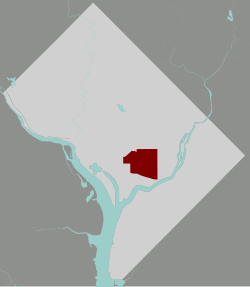
Back كابيتول هيل (واشنطن العاصمة) Arabic Kapitol Hill Azerbaijani Capitol Hill Czech Capitol Hill German Capitol Hill English Capitol Hill Spanish کپیتال هیل Persian Capitol Hill (Washington) French גבעת הקפיטול HE Capitol Hill Italian
The English used in this article or section may not be easy for everybody to understand. (November 2023) |
Capitol Hill Historic District | |
 G Street SE | |
 Map of Washington, D.C., with the Capitol Hill Historic District highlighted in maroon | |
| Location | Roughly bounded by Virginia Ave., SE., S. Capitol St., G St. NE., and 14th Sts. SE & NE; and roughly bounded by 8th St. NE, I-295, M St. SE and 11th St. SE Washington, D.C. |
|---|---|
| Coordinates | 38°53′23″N 77°00′40″W / 38.88972°N 77.01111°W |
| Website | www |
| NRHP reference No. | 76002127 (original) 03000585 (increase) |
| Significant dates | |
| Added to NRHP | August 27, 1976 |
| Boundary increase | July 3, 2003 |
Capitol Hill is the largest historic residential neighborhood in Washington D.C.. The neighborhood covers an area east of the United States Capitol along wide avenues. It is one of the oldest residential communities in Washington. Its two square miles house 35,000 people, so it is one of the most densely populated neighborhoods. The phrase "Capitol Hill" can sometime mean the United States Congress instead of the neighborhood.
Capitol Hill is also a hill as well as a neighborhood. The hill rises in the center of the District of Columbia and extends eastward. Pierre L'Enfant, as he began to develop his plan for the new Federal City in 1791, chose to locate the "Congress House" on the crest of the hill, facing the city, a site that L'Enfant characterized as a "pedestal waiting for a monument."
A large portion of the neighborhood is now designated as the Capitol Hill historic district. The name Capitol Hill is often used to refer to both the historic district and to the larger neighborhood around it. To the east of Capitol Hill lies the Anacostia River, to the north is the H Street corridor, to the south are the Southeast/Southwest Freeway and the Washington Navy Yard, and to the west are the National Mall and the city's central business district.